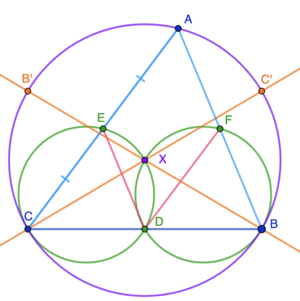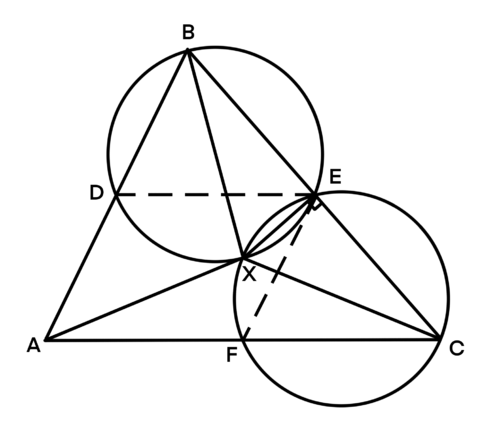Difference between revisions of "2011 AMC 12B Problems/Problem 20"
Technodoggo (talk | contribs) m (→Solution 6 (Trigonometry)) |
Megaboy6679 (talk | contribs) m |
||
| (2 intermediate revisions by one other user not shown) | |||
| Line 4: | Line 4: | ||
<math>\textbf{(A)}\ 24 \qquad \textbf{(B)}\ 14\sqrt{3} \qquad \textbf{(C)}\ \frac{195}{8} \qquad \textbf{(D)}\ \frac{129\sqrt{7}}{14} \qquad \textbf{(E)}\ \frac{69\sqrt{2}}{4}</math> | <math>\textbf{(A)}\ 24 \qquad \textbf{(B)}\ 14\sqrt{3} \qquad \textbf{(C)}\ \frac{195}{8} \qquad \textbf{(D)}\ \frac{129\sqrt{7}}{14} \qquad \textbf{(E)}\ \frac{69\sqrt{2}}{4}</math> | ||
| − | |||
| − | |||
| − | |||
==Solution 1 (Coordinates)== | ==Solution 1 (Coordinates)== | ||
| Line 13: | Line 10: | ||
Note that if we draw the perpendicular bisector of each side, we will have the circumcenter of <math>\triangle ABC</math> which is <math>P</math>, Also, since <math>m\angle ADP = m\angle AFP = 90^\circ</math>. <math>ADPF</math> is cyclic, similarly, <math>BDPE</math> and <math>CEPF</math> are also cyclic. With this, we know that the circumcircles of <math>\triangle ADF</math>, <math>\triangle BDE</math> and <math>\triangle CEF</math> all intersect at <math>P</math>, so <math>P</math> is <math>X</math>. | Note that if we draw the perpendicular bisector of each side, we will have the circumcenter of <math>\triangle ABC</math> which is <math>P</math>, Also, since <math>m\angle ADP = m\angle AFP = 90^\circ</math>. <math>ADPF</math> is cyclic, similarly, <math>BDPE</math> and <math>CEPF</math> are also cyclic. With this, we know that the circumcircles of <math>\triangle ADF</math>, <math>\triangle BDE</math> and <math>\triangle CEF</math> all intersect at <math>P</math>, so <math>P</math> is <math>X</math>. | ||
| − | The question now becomes | + | The question now becomes calculating the sum of the distance from each vertex to the circumcenter. |
We can calculate the distances with coordinate geometry. (Note that <math>XA = XB = XC</math> because <math>X</math> is the circumcenter.) | We can calculate the distances with coordinate geometry. (Note that <math>XA = XB = XC</math> because <math>X</math> is the circumcenter.) | ||
| Line 57: | Line 54: | ||
Since <math>ED</math> is a midline of <math>\triangle CAB,</math> we have that <math>\triangle CED \sim \triangle CAB</math> with a side length ratio of <math>1:2.</math> | Since <math>ED</math> is a midline of <math>\triangle CAB,</math> we have that <math>\triangle CED \sim \triangle CAB</math> with a side length ratio of <math>1:2.</math> | ||
| − | Consider a homothety of scale factor <math>2</math> with on <math>\triangle CED</math> | + | Consider a homothety of scale factor <math>2</math> with on <math>\triangle CED</math> concerning point <math>C</math>. Note that this sends <math>(CEDX)</math> to <math>(ABCC')</math> with <math>CX=XC'.</math> By properties of homotheties, <math>C,X,</math> and <math>C'</math> are collinear. Similarly, we obtain that <math>BX=XB',</math> with all three points collinear. Let <math>O</math> denote the circumcenter of <math>\triangle ABC.</math> It is well-known that <math>OX \perp CC'</math> and analogously <math>OX \perp BB'.</math> However, there is only one perpendicular line to <math>OX</math> passing through <math>X,</math>, therefore, <math>O</math> coincides with <math>X.</math> |
It follows that <math>AX=BX=CX=R,</math> where <math>R</math> is the circumradius of <math>\triangle ABC,</math> and this can be computed using the formula <cmath>R=\frac{abc}{4[ABC]},</cmath> from which we quickly obtain <cmath>R=\frac{65}{8} \implies AX+BX+CX=\boxed{\frac{195}{8}}.</cmath> | It follows that <math>AX=BX=CX=R,</math> where <math>R</math> is the circumradius of <math>\triangle ABC,</math> and this can be computed using the formula <cmath>R=\frac{abc}{4[ABC]},</cmath> from which we quickly obtain <cmath>R=\frac{65}{8} \implies AX+BX+CX=\boxed{\frac{195}{8}}.</cmath> | ||
Revision as of 18:31, 7 August 2023
Contents
Problem
Triangle ![]() has
has ![]() , and
, and ![]() . The points
. The points ![]() , and
, and ![]() are the midpoints of
are the midpoints of ![]() , and
, and ![]() respectively. Let
respectively. Let ![]() be the intersection of the circumcircles of
be the intersection of the circumcircles of ![]() and
and ![]() . What is
. What is ![]() ?
?
![]()
Solution 1 (Coordinates)
Let us also consider the circumcircle of ![]() .
.
Note that if we draw the perpendicular bisector of each side, we will have the circumcenter of ![]() which is
which is ![]() , Also, since
, Also, since ![]() .
. ![]() is cyclic, similarly,
is cyclic, similarly, ![]() and
and ![]() are also cyclic. With this, we know that the circumcircles of
are also cyclic. With this, we know that the circumcircles of ![]() ,
, ![]() and
and ![]() all intersect at
all intersect at ![]() , so
, so ![]() is
is ![]() .
.
The question now becomes calculating the sum of the distance from each vertex to the circumcenter.
We can calculate the distances with coordinate geometry. (Note that ![]() because
because ![]() is the circumcenter.)
is the circumcenter.)
Let ![]() ,
, ![]() ,
, ![]() ,
, ![]()
Then ![]() is on the line
is on the line ![]() and also the line with slope
and also the line with slope ![]() that passes through
that passes through ![]() .
.
![]()
So ![]()
and 
Solution 2 (Algebra)
Consider an additional circumcircle on ![]() . After drawing the diagram, it is noticed that each triangle has side values:
. After drawing the diagram, it is noticed that each triangle has side values: ![]() ,
, ![]() ,
, ![]() . Thus they are congruent, and their respective circumcircles are.
. Thus they are congruent, and their respective circumcircles are.
Let ![]() &
& ![]() be
be ![]() &
& ![]() 's circumcircles' respective centers. Since
's circumcircles' respective centers. Since ![]() &
& ![]() are congruent, the distance
are congruent, the distance ![]() &
& ![]() each are from
each are from ![]() are equal, so
are equal, so ![]() . The angle between
. The angle between ![]() &
& ![]() is
is ![]() , and since
, and since ![]() ,
, ![]() is also
is also ![]() .
. ![]() is a right triangle inscribed in a circle, so
is a right triangle inscribed in a circle, so ![]() must be the diameter of
must be the diameter of ![]() . Using the same logic & reasoning, we could deduce that
. Using the same logic & reasoning, we could deduce that ![]() &
& ![]() are also circumdiameters.
are also circumdiameters.
Since the circumcircles are congruent, circumdiameters ![]() ,
, ![]() , and
, and ![]() are congruent. Therefore, the solution can be found by calculating one of these circumdiameters and multiplying it by a factor of
are congruent. Therefore, the solution can be found by calculating one of these circumdiameters and multiplying it by a factor of ![]() . We can find the circumradius quite easily with the formula
. We can find the circumradius quite easily with the formula ![]() , such that
, such that ![]() and
and ![]() is the circumradius. Since
is the circumradius. Since ![]() :
:
![]()
After a few algebraic manipulations:
![]() .
.
Solution 3 (Homothety)
Let ![]() be the circumcenter of
be the circumcenter of ![]() and
and ![]() denote the length of the altitude from
denote the length of the altitude from ![]() Note that a homothety centered at
Note that a homothety centered at ![]() with ratio
with ratio ![]() takes the circumcircle of
takes the circumcircle of ![]() to the circumcircle of
to the circumcircle of ![]() . It also takes the point diametrically opposite
. It also takes the point diametrically opposite ![]() on the circumcircle of
on the circumcircle of ![]() to
to ![]() Therefore,
Therefore, ![]() lies on the circumcircle of
lies on the circumcircle of ![]() Similarly, it lies on the circumcircle of
Similarly, it lies on the circumcircle of ![]() By Pythagorean triples,
By Pythagorean triples, ![]() Finally, our answer is
Finally, our answer is ![]()
Solution 4 (basically Solution 1 but without coordinates)
Since Solution 1 has already proven that the circumcenter of ![]() coincides with
coincides with ![]() , we'll go from there. Note that the radius of the circumcenter of any given triangle is
, we'll go from there. Note that the radius of the circumcenter of any given triangle is ![]() , and since
, and since ![]() and
and ![]() , it can be easily seen that
, it can be easily seen that ![]() and therefore our answer is
and therefore our answer is ![]()
Solution 5
Since ![]() is a midline of
is a midline of ![]() we have that
we have that ![]() with a side length ratio of
with a side length ratio of ![]()
Consider a homothety of scale factor ![]() with on
with on ![]() concerning point
concerning point ![]() . Note that this sends
. Note that this sends ![]() to
to ![]() with
with ![]() By properties of homotheties,
By properties of homotheties, ![]() and
and ![]() are collinear. Similarly, we obtain that
are collinear. Similarly, we obtain that ![]() with all three points collinear. Let
with all three points collinear. Let ![]() denote the circumcenter of
denote the circumcenter of ![]() It is well-known that
It is well-known that ![]() and analogously
and analogously ![]() However, there is only one perpendicular line to
However, there is only one perpendicular line to ![]() passing through
passing through ![]() , therefore,
, therefore, ![]() coincides with
coincides with ![]()
It follows that ![]() where
where ![]() is the circumradius of
is the circumradius of ![]() and this can be computed using the formula
and this can be computed using the formula ![]() from which we quickly obtain
from which we quickly obtain ![]()
Solution 6 (Trigonometry)
![]() ,
, ![]() , as the angles are on the same circle.
, as the angles are on the same circle.
![]() ,
, ![]()
![]() ,
, ![]()
![]() ,
, ![]()
Therefore ![]() , and
, and ![]() is the angle bisector of
is the angle bisector of ![]() . By the angle bisector theorem
. By the angle bisector theorem ![]() ,
, ![]() . In a similar fashion
. In a similar fashion ![]() , where
, where ![]() is the circumcircle of
is the circumcircle of ![]() .
.
By the law of cosine, ![]() ,
, 
By the extended law of sines, ![]() ,
, ![]()
![]()
See also
| 2011 AMC 12B (Problems • Answer Key • Resources) | |
| Preceded by Problem 19 |
Followed by Problem 21 |
| 1 • 2 • 3 • 4 • 5 • 6 • 7 • 8 • 9 • 10 • 11 • 12 • 13 • 14 • 15 • 16 • 17 • 18 • 19 • 20 • 21 • 22 • 23 • 24 • 25 | |
| All AMC 12 Problems and Solutions | |
The problems on this page are copyrighted by the Mathematical Association of America's American Mathematics Competitions. 











